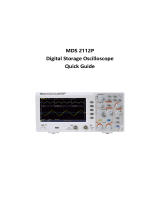
SIGLENT
IV SDS1000CML/CNL/DL Service Manual
Contents
Guaranty and Declaration............................................................................ I
General Safety Summary............................................................................ II
General Features and Specifications ........................................................1
General Features ....................................................................................1
Specifications..........................................................................................2
Prepare Information ....................................................................................6
Functional checking ................................................................................6
Power-on Inspection .........................................................................6
Default Setup ....................................................................................7
Probe Compensation ........................................................................9
Auto Setup......................................................................................10
Self Calibration ...............................................................................10
Interface Test ........................................................................................12
USB Host Test ................................................................................12
USB Device Test.............................................................................14
LAN Test .........................................................................................15
Pass/Fail Test .................................................................................16
Performance Test......................................................................................18
Verify Test Results ..........................................................................19
Self Test..........................................................................................19
Self Calibration ...............................................................................19
To verify DC Gain Accuracy ..................................................................20
To verify Bandwidth...............................................................................21
To verify Time Base Accuracy ...............................................................23
To verify Trigger Sensitivity ...................................................................24
Adjusting Procedures ...............................................................................26
Warming up ....................................................................................26
Self calibration ................................................................................26
Required Equipments .....................................................................26
Software Installation........................................................................26
Adjusting steps ...............................................................................26
Assembly Procedures...............................................................................28
Security Consideration....................................................................28
List of Modules................................................................................28
Required Tools................................................................................29
Disassembly Procedures ................................................................29
Removing the Rear Panel.....................................................................31
Removing the Top Metal Cover.............................................................33
Removing the Rear Metal Cover...........................................................32
Removing the Power Supply Module ....................................................34
Removing the Interface Module ............................... 错误!未定义书签。
Removing the Fan Module....................................................................38
Removing the Main Board.....................................................................36
Removing the Metal Shelf.....................................................................35
Removing the Display Module ..............................................................39
Removing the Front Panel Module........................... 错误!未定义书签。




















